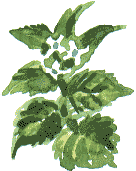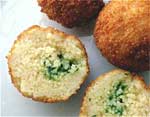On the Trail of the Wild Garlic
 Some
years ago Sharon Crowder, then a student at Illinois State University,
wrote to me asking if I could help her find more information on garlic
mustard for a lab report that she was writing Some
years ago Sharon Crowder, then a student at Illinois State University,
wrote to me asking if I could help her find more information on garlic
mustard for a lab report that she was writing
I have quite a bit of information on the subject, but despite it's
unorthodox nature, I am contemplating including a recipe for in it.
I'm rather sure that I will have a hard time convincing my professor
that a recipe belongs in this paper, so if nothing else, I would love
one for my own personal use. In my way of thinking, however, if we can
understand the value that was placed on the plant years ago when it
was used commonly (it has fallen to disrespect among American conservationists
due to it's invasive nature, displacing native plants), it will add
to our appreciation of the plant
Lora Conrad, who has been researching how to get rid
of garlic mustard and how early settlers must have used it, tells me:
It's become a serious invasive pest in our woodlands here in southeastern
Iowa along the Des Moines River. Like dandelions, it
is everywhere. It's pretty in the spring, but does crowd out everything
below it.
A pound a bunch!
In Flora Britannica, 1996, Richard Mabey writes;
'Garlic Mustard or Jack-by-the-hedge, Alliara petiolata,
is an abundant herb of hedge-banks and woods, smelling mildly of garlic.
It has long been used as a flavouring: in sauces for fish and lamb in
the seventeenth and eighteenth centuries, and as an ingredient for spring
salads today. In 1993 it was being sold for a pound a bunch in a smart
Italian delicatessen in London's Covent Garden. Jack-by-the-hedge is
a biennial, and the soft nettle-shaped leaves can be picked from September,
when they first begin to show, until late spring, when the brilliant
white flowers appear.
'All Sauce'
David Bellamy sums up the its uses in Blooming Bellamy, Herbs
and Herbal Healing, 1993:
'CONTAINS sulphur-rich heterosides, glycosides and an essential oil;
USES: (Classic and Herbal Medicine): condiment, warming body rub, poultices,
diuretic and gout;
Homeopathic: rheumatism and asthma.
He writes that it was 'also known as 'All Sauce' as it makes a good all-round
condinment.'
As Richard Mabey mentions, in the 17th century it was used as a flavouring
for salt fish, roast lamb and in salad.
Related Links
 My
thanks to Marcus Harrison and Lora Conrad for the following
links: My
thanks to Marcus Harrison and Lora Conrad for the following
links:
Garlic
Mustard Couscous Kievs from The
Really WILD Food Guide
“Wildman”
Steve Brill includes photographs and a watercolour of Garlic
Mustard on his website and recipes for Garlic Mustard
Pesto and Wild Mustard Seed Mayonnaise. Follow
the links to 'Plants' and 'Recipes'. Garlic
Mustard Pesto will be featured in Brill's The Wild Vegetarian
Cookbook.
Richard Bell, richard@willowisland.co.uk |